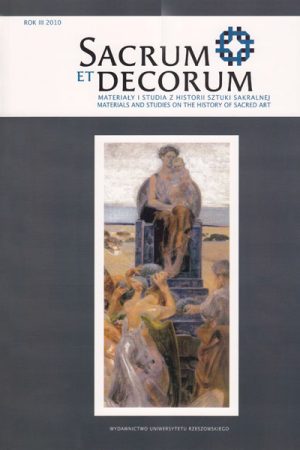Zapoznana pasja architekta Franciszka Mączyńskiego
Słowa kluczowe:
Franciszek Mączyński, witraż, oszklenie ołowiowe , Polska , XX wiek, Krakowski Zakład Witrażów i Mozaiki S.G. ŻeleńskiAbstrakt
Franciszek Mączyński (1874–1947), znany architekt, znawca i miłośnik zabytków, przez całe życie zawodowe z widocznym zamiłowaniem projektował witraże, co nie zostało dotąd dostatecznie zauważone przez badaczy, skupiających się raczej na jego działalności architektonicznej. Witraże Mączyńskiego dopełniają wystroju wnętrz budowli sakralnych i świeckich, niekiedy wzniesionych według jego projektów. Wiele z nich to oszklenia ołowiowe ze szkła bezbarwnego, półprzejrzystego, w które wkomponowano nieduże różnokolorowe plakiety z herbami (kaplica zamkowa w Żywcu, ok. 1905) lub – najczęściej – z motywami architektonicznymi (przeważają wieże, sygnaturki i kopuły krakowskich kościołów, które jako motyw zastosował po raz pierwszy ok. 1904 roku w oknach krużganków klasztoru Karmelitanek Bosych przy ul. Łobzowskiej w Krakowie). Przeciwieństwem owych miniatur architektonicznych jest znakomity witrażowy wizerunek drewnianego kościoła w Komorowicach Krakowskich, wypełniający nadświetle wejścia do nowej, murowanej świątyni w tejże miejscowości. Interesujące oszklenie ołowiowe okien zastosował architekt w krużgankach klasztoru Franciszkanów w Krakowie, których restauracją kierował (ok. 1908). Mączyńskiemu nieobce były kompozycje figuralne, których przykładem są witraże z postaciami świętych w kościele w Mogilanach pod Krakowem i Karmelitów Trzewiczkowych w Krakowie (1930). W witrażach kościelnych Mączyński stosował też motywy o charakterze dekoracyjno-symbolicznym (wazony wypełnione kwiatami i owocami z wkomponowanym w nie sercem, użyte w oknach nawy kościoła Jezuitów przy ul. Kopernika w Krakowie, 1912). Ten sam temat – już bez symbolicznego akcentu – wykorzystywał później w witrażach przeznaczonych do budowli świeckich. W witrażach we wnętrzach chętniej przedstawiał jednak motywy ze świata przyrody lub architekturę. Tworzenie witraży było nie tylko pasją Franciszka Mączyńskiego, ale i trudem wieloletniej pracy na stanowisku kierownika artystycznego „Krakowskiego Zakładu Witrażów i Mozaiki S.G. Żeleński”, dla którego projektował także pawilony wystawowe (z których najciekawszy był ten na Powszechną Wystawę Krajową w Poznaniu w roku 1929).
Downloads
Pobrania
Opublikowane
Jak cytować
Numer
Dział
Licencja
Prawa autorskie (c) 2010 Sacrum et Decorum

Utwór dostępny jest na licencji Creative Commons Uznanie autorstwa – Użycie niekomercyjne – Bez utworów zależnych 4.0 Międzynarodowe.
Zgodnie z polityką Open Access autorzy zachowują pełnię praw autorskich do swoich artykułów – bez ograniczeń.
Autorzy mogą deponować swoje artykuły w wybranym przez siebie repozytorium.


